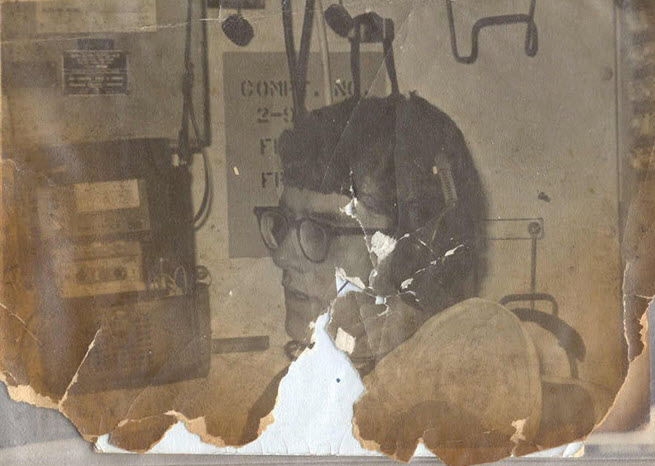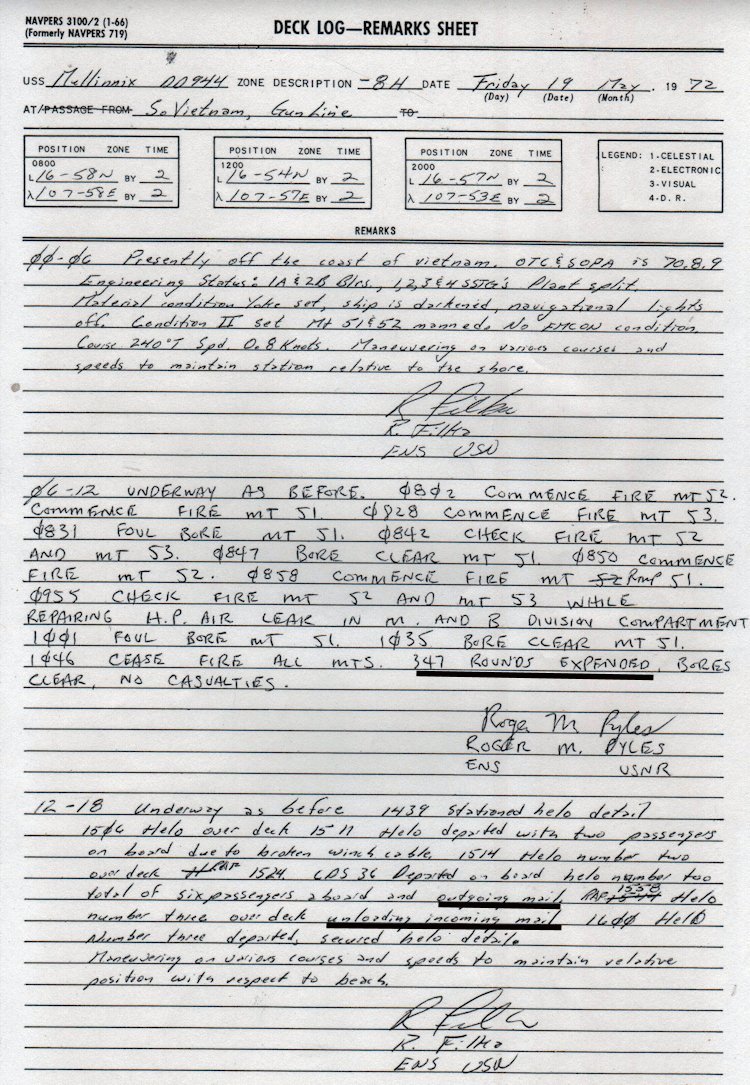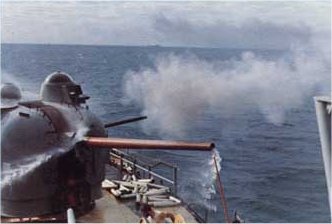  Click on pic @ left to hear incoming | Pacific Stars & StripesThis Ship’s Business Is DestroyingFriday, 26 May 1972
By Jal Drake |
|
ABOARD THE DESTROYER MULLINNX, Vietnam - "That guy’s got guts," the red-bearded Navy chief said as he focused his binoculars on a lumbering speck. "I’d be out of the SOB and running."
The speck, a North Vietnamese truck or armored vehicle, skittered down the tortured strip of beach like an insect touched by match flame. Explosions crept after it - grayish puffs tinged with reddish sand, blossoms of smoke like lethal shrubbery with a spray of iron thorns. The five-inch guns on the Mullinnix hurled away more packets of explosive - first the sharp, deafening slam, then the cloud of pungent fume and the small blizzard of seared cork and pulverized cardboard wadding that showered spectators along the rail. Three-and-a-half miles offshore, 12 miles from a ruined town called Quang Tri, they were coldly moved by the magnified spectacle of impersonally dealt death. Sixty enemy soldiers had been moving down the beach in preposterously exposed fashion; 10 were seized up by the blasts, hideously mangled, flung aside. One olive-colored vehicle was a flickering pyre and another swayed away frantically as the explosions grasped for it, finally vanishing behind a sand dune. A fleet of flimsy sampans was blown away. A coastal fishing village was erased. A laconic voice from the hovering Air Force spotter told it all: "Best shooting I’ve seen in six weeks. Terrific job. These guys really know how to pound it out." But there were no cheers, handshakes or satisfied smiles among the youngsters on the Mullinnix, a 3,850-ton destroyer recently called from Norfolk and softer Atlantic Fleet duty to join a procession of warships called The Gunline. Their morale was good, but silent and cohesive - the kind of purposeful spirit common on a smaller ship with small town closeness. The gunfire mission was little more than trained response. Many had other things to think about. For Ensign Alan Nibbs, who wore khaki cutoffs and a picturesque beard that made him look like Donald Sutherland in M*A*S*H, there was a hasty marriage and a two-day honeymoon - a necessity dictated by sudden orders that took him from the azure Virginia coastline to a bench that has a scrubby frowse of trees and was clotted by the worst kind of pollution. Others had trouble erasing images of a leisurely cruise to Vera Cruz, Panama and Curacao - and of sudden and painful good-byes that were made just a few weeks before they passed their second day on a long line of gray vessels that pounded the shore and targets inland. Some spoke their mind on sharper issues. 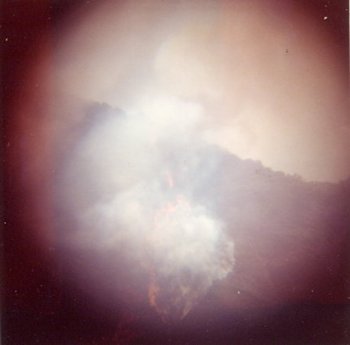
"I’m against this war," said Radioman S. C. Neil E. Tapman of Baltimore. "I don’t think we’re fighting for American freedom here. But if Nixon says this will get us out, fine. If not, well, we’ve wasted a few more people. We’re all part of this ship and that’s what keeps us going. We all trained for this job. Now we’re doing it." He had a beard too. Well-trimmed ones are tolerated, along with spirited opinions of dissent - providing they don’t lead to demonstrations or sit-ins on the quarterdeck. The hysteria of gunfire had shaken the exotic nude on the wardroom wall - the one that replaces a more pallid painting of two sailboats, posted for the benefit of wives and sweethearts when the destroyer is back in Norfolk. Cmdr. James R. Cannon, the captain, poured coffee for visitors and explained this paradoxical Age of Aquarius and Zumwalt. "Well, they’re not enthusiastic about being here but they are enthusiastic about going to a new part of the world and being part of this ship. There are no hawks, as such, on board. But if you sit down and ask a man about the war, he might not sound too different from Dr. Spock." Seaman Apprentice Roger Thornton, who is 19 and comes from Hartford, explained he was proud of the efficient way he and the others in the ship’s magazine passed ammunition to gunners, who carried on a war he did not believe in. "I just want to get out", he said, "I wish it would stop, I think we’re wrong by being here. I don’t think we should be. If they can’t fight their own war xxxxx xxxx it’s a nice ship. I don’t mind being on it. I just don’t like being here." There it is. |
__________
  | The Last Gun Ship - History of USS Mullinnix DD-944Excerpt From The Historic Novelby Frank A. Wood |
|
On 17 May, it was a beautiful little fishing village on a white beach. After the sunset on 18 May, it was gone. FTG3 Greg "Birdman" Berry watched from the MK56 Forward Director and SM3 Ken "Gus" Gustin watched the destruction through the “big eyes”.
The deafening concussions, as the B-52 bombs stitched a dotted-line of destruction down the white sandy beach. Jets descending toward the jungle canopy were strung like pearls across a tuxedo black early morning sky. And then? Then, Naval Gunfire Support from 30+ ships. The spotters could hear the rounds from our offshore battery arcing with a whooshing sound out of their trajectory, exploding onto the beach, shaking the earth under them. The sun was just breaking the horizon, veiled with gray-white smoke form the still smoldering barrels. As Mullinnix shells rained to the ground, huge fountains of sand blossomed into the sky. The sound and the cordite smell were exhilarating. Each time I pulled the trigger, I never knew just who it was we were saving or killing. As it turned out, it was pretty much ALL killing as there wasn’t anyone to save just yet (South Vietnamese Marines had not hit the beach yet). If there is no enemy to hear a shell hit, does it still make a noise when it detonates? The Mullinnix Gunner’s Mates were the first to hear them. B-52s making their final run on the beach. The very sky shuttered against the bombers. Mullinnix could hear the sound of a giant’s footsteps as the first of the bombs began to explode on the beach. Step by step, the thumb and thunder of the bombs exploding marched closer and closer. The sky was alive with the flaring light from bursting detonations and the rising fire followed by giant gushers of sand, sea water, and flaming vegetation. The arc lights pulsated on the horizon for miles. With continuous bomb flashes we could feel the shock wave pressing at our eardrums, the ship shivered beneath our feet and the empty powder canisters rattled and danced on the deck. The sky lit up, clouds of fire and smoke slashed in a blinding symphony of lurid pink and green. A stiff breeze ruffled the surface of the water. The wet-ash stink of still smoldering fires was lost on the water’s surface before it could reach Mullinnix. Along with it the dark, rich scent of an open grave. The explosions lit up the underside of the low hanging clouds like gigantic flashbulbs. Crumpled roar of exploding bombs in the distance quickly turned into enormous flashes of brilliant light, followed by a jarring clap of thunder, sheets of brilliance burning across the flashing sky. The Mullinnix contributed to this rain of death in a big way by kicking a hole in the sky with 722 rounds (53,000 pounds of explosives) of 5”-54 shells in 6 hours and 9 minutes. The aluminum powder cases, sparkled in the sunlight as they were disgorged under each 5” barrel, bounced, and danced onto the deck. Baboom. Baboom. In the middle distance, the bombs continued their thundering symphony. Above, the clouds flashed and flared with pink and orange, fire raining from the flashing fire-lit sky. The clouds reflected flashes from enemy shore batteries. Even though we controlled the skies, a speck in the sky would get our attention and worry us big time! Black smoke belched out of an enemy MIG. Its engine sputtered, and the plane began a death spin towards the earth. Arc-lights danced in the clouds. You knew the VC were in for a long day – again. The mountains watching the war like a Nebraska farmer back home watching the nightly news. With the largest assembly of naval gunfire support ships in the Vietnam War, explosions went off one after the other, earsplittingly loud and accompanied by intensely white flashes. Smoke curled into the sky. Screeching shells tore through the sky, slamming into a row of trees, shattering trucks and scorching the landscape. Quickly, the Navy ships found their range. Another round of incoming mail ripped the sky and bracketed the narrow beach with explosions. The column of enemy equipment steered through a rain of debris as sand, stones, and shattered branches peppered the air. Shrieks of falling shells descended from the sky. The spotters had found their range and Mullinnix and the other ships were busy obliterating a good part of the convoy and all the village. The surrounding forest bloomed with red-black geysers of fire, dirt, and sand. A fleet of flimsy sampans was blown away. The coastal fishing village was erased. A laconic voice from the hovering Air Force spotter told it all: "Best shooting I’ve seen in six weeks. Terrific job. These guys really know how to pound it out." The sudden attack caught the enemy unaware, ripping into bone and flesh, turning men into plumes of pink mist. tracer rounds set their skin and clothing on fire. And they ignited the dry grass on the beach. The grass burned. The dead and wounded burned. Explosions blossomed like a garland of brown flowers across a distant field. A plume of sudden red & orange marked a fuel tank taking a direct hit. Bodies were everywhere. Tangled limbs and sprawled torsos displayed in every conceivable form of twisted agony. Burned bodies. Dismembered bodies. Bodies so untouched the men appeared to be sleeping. Then there was the baby… A baby was sitting on the sand just outside a village hut when one of our shells hit the hut and it disintegrated. The VC had been spotted using the village and Mullinnix’ orders were to wipe out the village. No survivors! As best it could in the middle of this rain of terror, the baby struggled to crawl across the sand towards the protection of what was left of the jungle canopy. All the while, Mullinnix shells exploded in its wake, slowly closing the gap between the last explosion and the baby itself. Each shell marching closer and closer and bloody closer… I took a picture from my wallet and stared at it, suddenly moved. My life, then. How old had I been? Eight? I remembered the day it had been taken. I felt I was there, my face flushed. Death, suffering, and chaos didn’t care how smart you were, or careful, or fast, or how deep you dug in, or what state you were from. War will rip you apart, bury you in a stinking shell hole, sever a vein so you can watch yourself bleed to death, and not give a damn. Life animates us, makes us whole. Death sweeps all that away, leaving a twisted imitation of the living, instantly recognizable as no more than cooling dead flesh. Afterwards, refugees streamed south on the beach for days. To this day, I pray to God, that baby was one of them… I just can’t forget. To be continued (or forgotten)... |
__________
Stars & Stripes 26 May 1972 (PDF File)
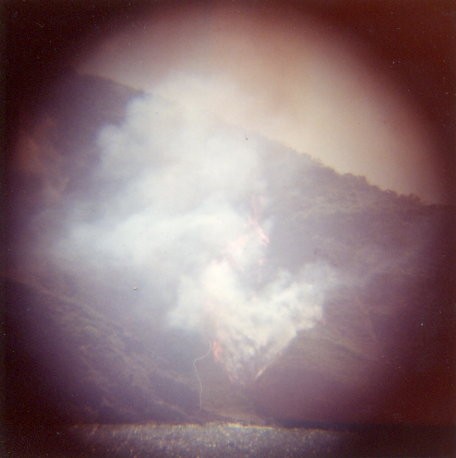 A reporter asked one of the Mux Gunners Mates what he felt when he fired the gun mount – killing Viet Cong. The gunner replied, “Concussion and recoil!”
A reporter asked one of the Mux Gunners Mates what he felt when he fired the gun mount – killing Viet Cong. The gunner replied, “Concussion and recoil!”
